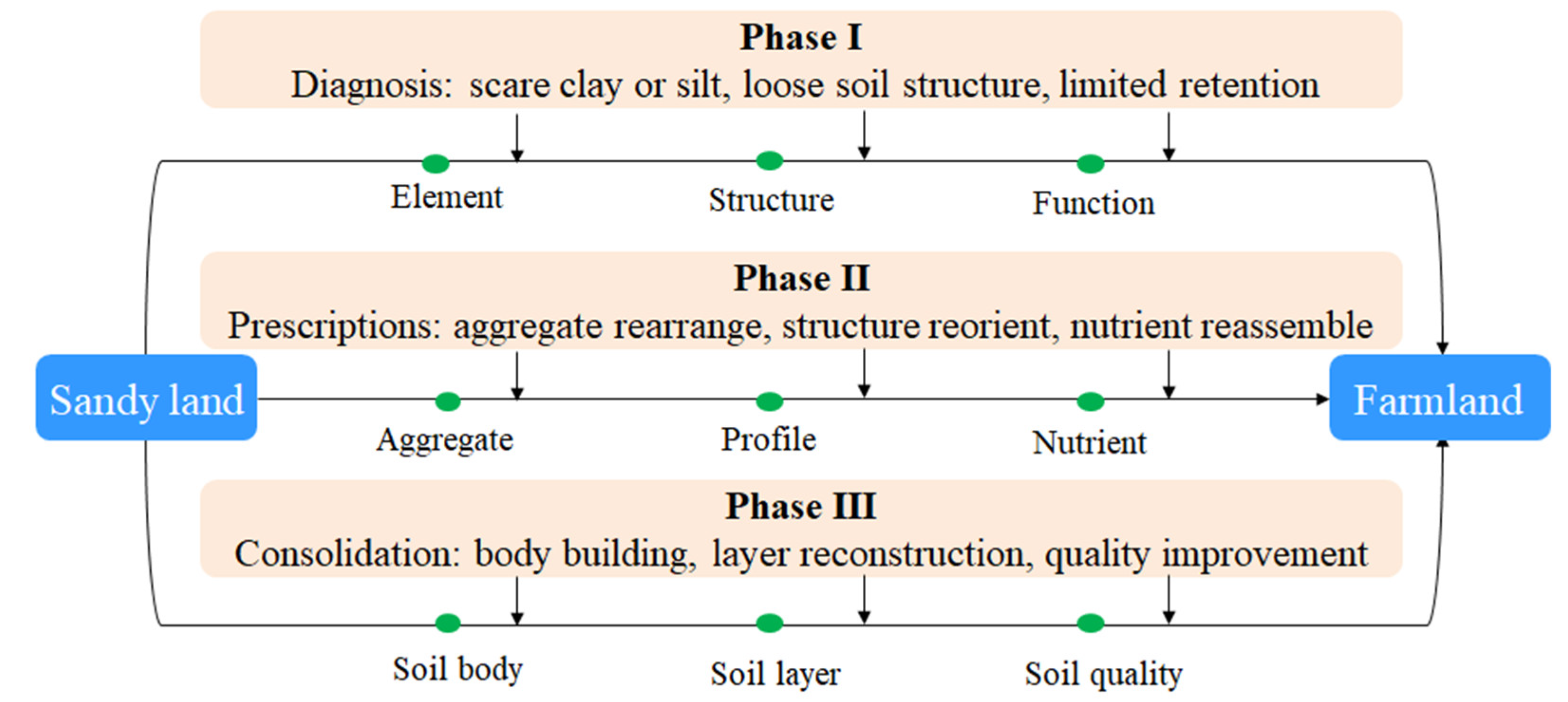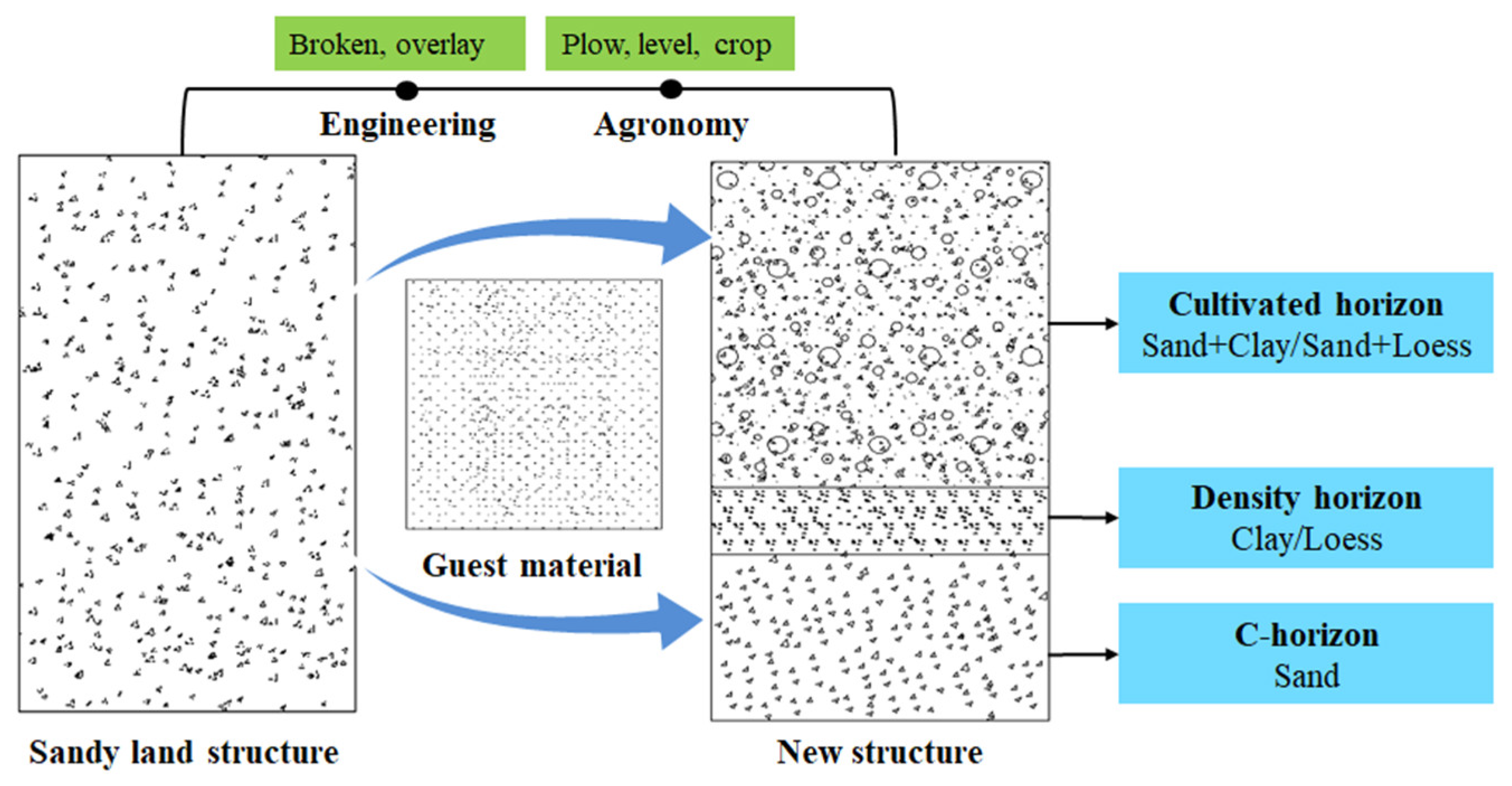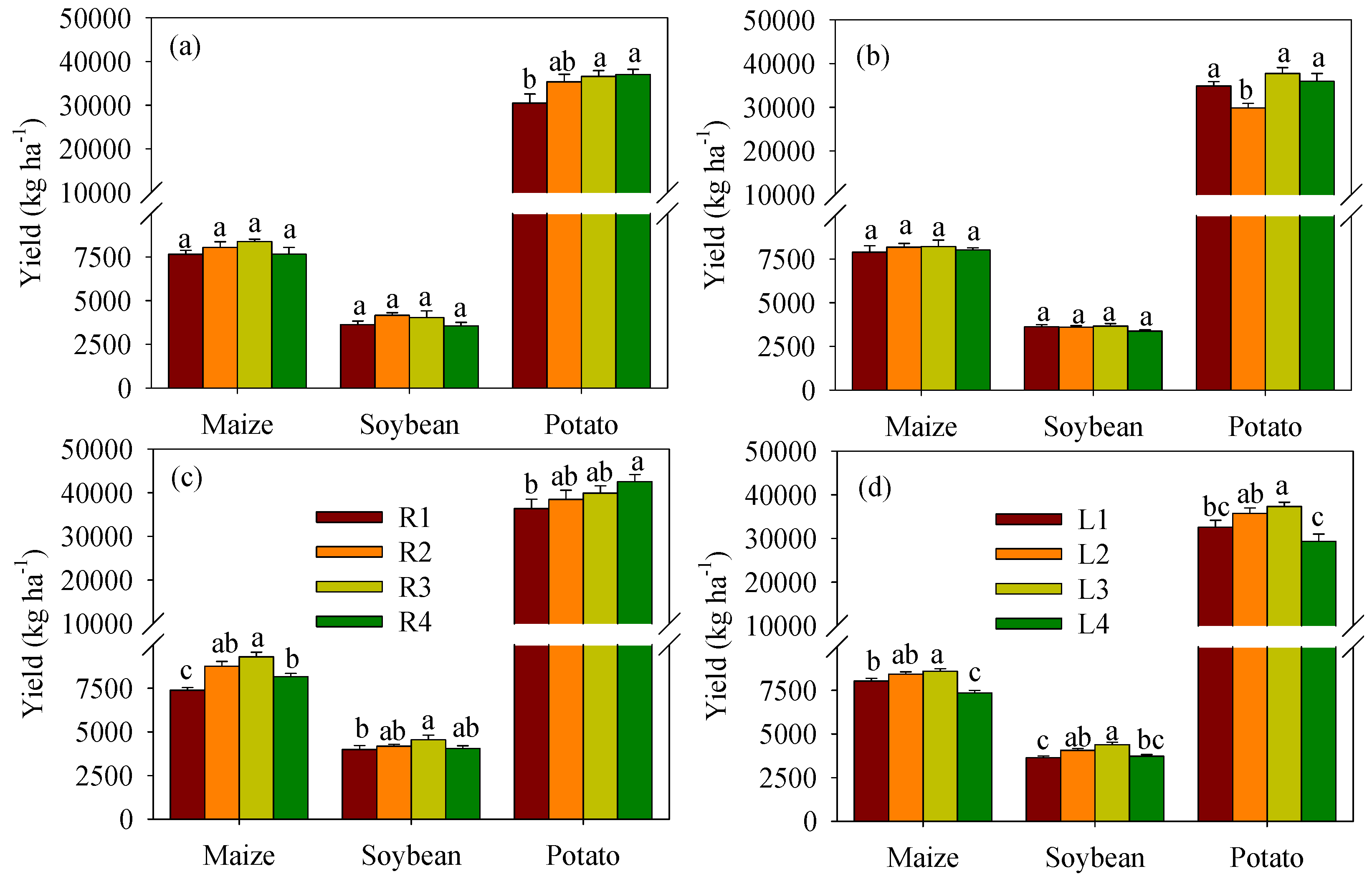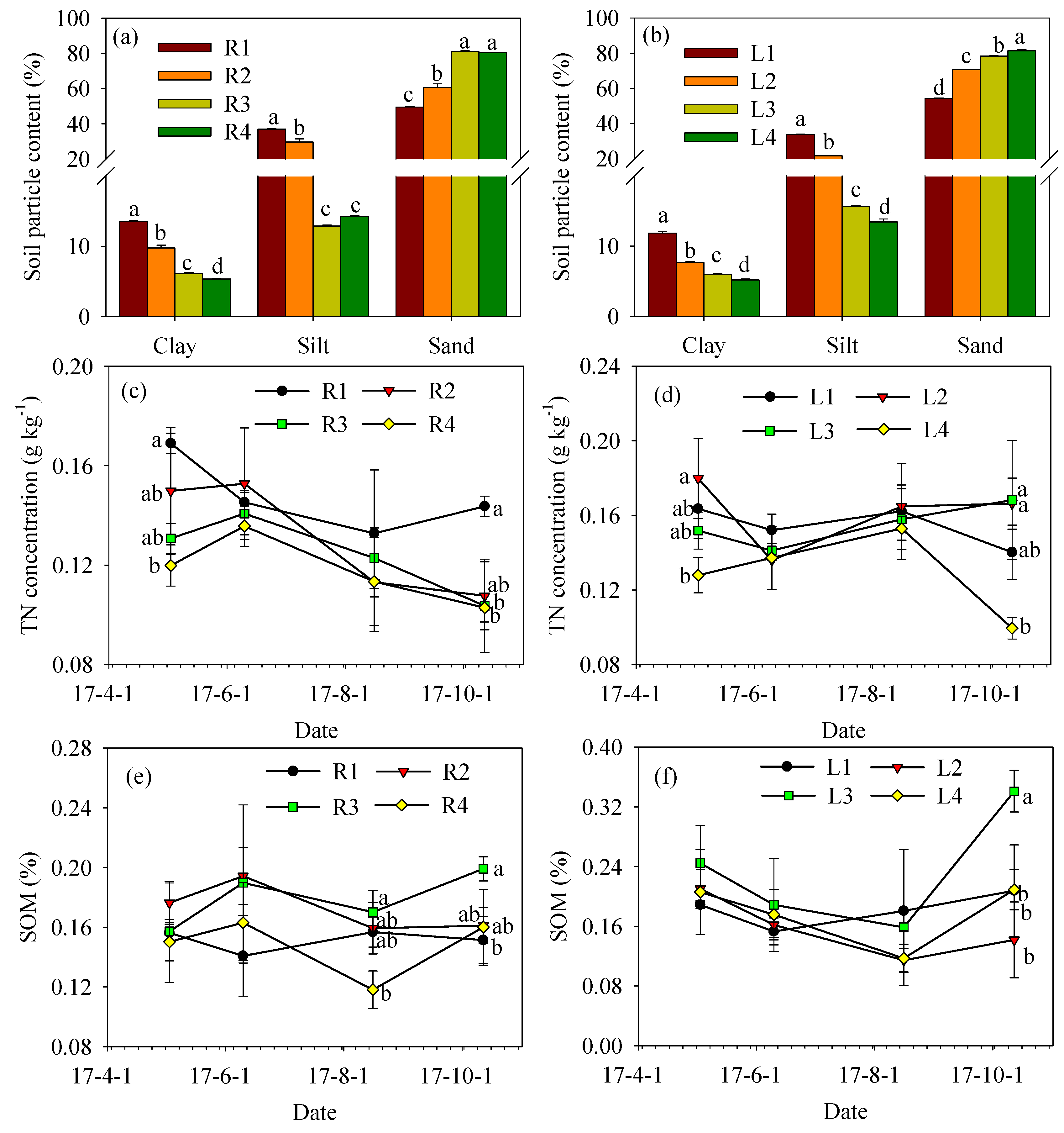Land Engineering Consolidates Degraded Sandy Land for Agricultural Development in the Largest Sandy Land of China
Abstract
1. Introduction
2. Sandy Land Diagnosis and Structural Consolidation
3. Field Experiment in Mu Us Sandy Land
3.1. Materials and Methods
3.1.1. Site Description
3.1.2. Engineering Design and Crop Management
3.1.3. Sampling and Measurement
3.1.4. Statistical Analysis
3.2. Results
3.2.1. Engineering Cost
3.2.2. Crop Yield
3.2.3. Soil Properties
3.2.4. Root Biomass
4. Discussion
5. Conclusions
Author Contributions
Funding
Conflicts of Interest
References
- IPCC. Summary for Policymakers. In Climate Change and Land: An IPCC Special Report on Climate Change, Desertification, Land Degradation, Sustainable Land Management, Food Security, and Greenhouse Gas Fluxes in Terrestrial Ecosystems; Shukla, P.R., Skea, J., Calvo Buendia, E., Masson-Delmotte, V., Pörtner, H.-O., Roberts, D.C., Zhai, P., Slade, R., Connors, S., van Diemen, R., et al., Eds.; IPCC: Geneva, Switzerland, 2019. [Google Scholar]
- Cowie, A.L.; Orr, B.J.; Sanchez, V.M.C.; Chasek, P.; Crossman, N.D.; Erlewein, A.; Louwagie, G.; Maron, M.; Metternicht, G.I.; Minelli, S.; et al. Land in balance: The scientific conceptual framework for Land Degradation Neutrality. Environ. Sci. Policy 2018, 79, 25–35. [Google Scholar] [CrossRef]
- Luo, W.; Bai, H.T.; Jing, Q.N.; Liu, T.; Xu, H. Urbanization-induced ecological degradation in Midwestern China: An analysis based on an improved ecological footprint model. Resour. Conserv. Recycl. 2018, 137, 113–125. [Google Scholar] [CrossRef]
- Lal, R.; Lorenz, K.; Hüttl, R.F.; Schneider, B.U.; Von Braun, J. Recarbonization of the Biosphere: Ecosystems and the Global Carbon Cycle; Springer: Berlin, Germay, 2012. [Google Scholar]
- IPBES. Summary for Policymakers of the Thematic Assessment Report on Land Degradation and Restoration of the Intergovernmental Science-Policy Platform on Biodiversity and Ecosystem Services; Scholes, R., Montanarella, L., Brainich, A., Barger, N., ten Brink, B., Cantele, M., Erasmus, B., Fisher, J., Gardner, T., Holland, T.G., et al., Eds.; IPBES Secretariat: Bonn, Germany, 2018. [Google Scholar]
- Lal, R. Soils and world food security. Soil Tillage Res. 2009, 102, 1–4. [Google Scholar] [CrossRef]
- van Haren, N.; Fleiner, R.; Liniger, H.; Harari, N. Contribution of community-based initiatives to the sustainable development goal of Land Degradation Neutrality. Environ. Sci. Policy 2019, 94, 211–219. [Google Scholar] [CrossRef]
- Zhang, K.F.; Li, X.W.; Zhou, W.H.; Zhang, D.X.; Yu, Z.R. Land resource degradation in China: Analysis of status, trends and strategy. Int. J. Sustain. Dev. World Ecol. 2006, 13, 397–408. [Google Scholar] [CrossRef]
- Ci, L.J.; Yang, X.H. Desertification and Its Control in China; Higher Education Press: Beijing, China; Springer-Verlag: Berlin/Heidelberg, Germany, 2010. [Google Scholar]
- Bao, Y.S.; Cheng, L.L.; Bao, Y.F.; Yang, L.; Jiang, L.; Long, C.; Kong, Z.; Peng, P.; Xiao, J.; Qi, L.U. Desertification: China provides a solution to a global challenge. Front. Agric. Sci. Eng. 2017, 4, 402–413. [Google Scholar] [CrossRef]
- Sterk, G.; Stoorvogel, J.J. Desertification—scientific versus political realities. Land 2020, 9, 156. [Google Scholar] [CrossRef]
- Zhang, X.M.; Zhang, C.X.; Hasi, E.; Dong, Z.B. Has the Three Norths Forest Shelterbelt Program solved the desertification and dust storm problems in arid and semiarid China? J. Arid Environ. 2010, 74, 13–22. [Google Scholar]
- Feng, Q.; Tian, Y.Z.; Yu, T.F.; Yin, Z.L.; Cao, S.X. Combating desertification through economic development in northwestern China. Land Degrad. Dev. 2019, 30, 910–917. [Google Scholar] [CrossRef]
- Bryan, B.A.; Gao, L.; Ye, Y.Q.; Sun, X.F.; Connor, J.D.; Crossman, N.D.; Stafford-Smith, M.; Wu, J.G.; He, C.Y.; Yu, D.Y.; et al. China’s response to a national land-system sustainability emergency. Nature 2018, 559, 193–204. [Google Scholar] [CrossRef]
- Jala, S.; Goyal, D. Fly ash as a soil ameliorant for improving crop production—A review. Bioresour. Technol. 2006, 97, 1136–1147. [Google Scholar] [CrossRef] [PubMed]
- Wu, L.; Zhu, Q.H.; Yang, L.; Li, B.L.; Hu, C.X.; Lan, S.B. Nutrient transferring from wastewater to desert through artificial cultivation of desert cyanobacteria. Bioresour. Technol. 2018, 247, 947–953. [Google Scholar] [CrossRef] [PubMed]
- Lan, S.B.; Wu, L.; Yang, H.J.; Zhang, D.L.; Hu, C.X. A new biofilm based microalgal cultivation approach on shifting sand surface for desert cyanobacterium Microcoleus vaginatus. Bioresour. Technol. 2017, 238, 602–608. [Google Scholar] [CrossRef] [PubMed]
- Weber, J.; Karczewska, A.; Drozd, J.; Licznar, M.; Licznar, S.; Jamroz, E.; Kocowicz, A. Agricultural and ecological aspects of a sandy soil as affected by the application of municipal solid waste composts. Soil Biol. Biochem. 2007, 39, 1294–1302. [Google Scholar] [CrossRef]
- Borchard, N.; Siemens, J.; Ladd, B.; Moller, A.; Amelung, W. Application of biochars to sandy and silty soil failed to increase maize yield under common agricultural practice. Soil Tillage Res. 2014, 144, 184–194. [Google Scholar] [CrossRef]
- Han, J.C.; Liu, Y.S.; Zhang, Y. Sand stabilization effect of feldspathic sandstone during the fallow period in Mu Us Sandy Land. J. Geogr. Sci. 2015, 25, 428–436. [Google Scholar] [CrossRef]
- Khaleghi, M.; Rowshanzamir, M.A. Biologic improvement of a sandy soil using single and mixed cultures: A comparison study. Soil Tillage Res. 2019, 186, 112–119. [Google Scholar] [CrossRef]
- Ding, Z.L.; Sun, J.M.; Liu, T.S.; Zhu, R.X.; Yang, S.L.; Guo, B. Wind-blown origin of the Pliocene red clay formation in the central Loess Plateau, China. Earth Planet. Sci. Lett. 1998, 161, 135–143. [Google Scholar] [CrossRef]
- Liu, Y.S.; Zheng, X.Y.; Wang, Y.S.; Cao, Z.; Li, Y.H.; Wu, W.H.; Liu, Z.J.; Liu, H.H.; Li, R. Land consolidation and modern agricultural: A case study from soil particles to agricultural systems. J. Geogr. Sci. 2018, 28, 1864–1874. [Google Scholar]
- Li, N.; Yan, C.Z.; Xie, J.L. Remote sensing monitoring recent rapid increase of coal mining activity of an important energy base in northern China, a case study of Mu Us Sandy Land. Resour. Conserv. Recycl. 2015, 94, 129–135. [Google Scholar] [CrossRef]
- Li, Y.R.; Cao, Z.; Long, H.L.; Liu, Y.S.; Li, W.J. Dynamic analysis of ecological environment combined with land cover and NDVI changes and implications for sustainable urban–rural development: The case of Mu Us Sandy Land, China. J. Clean. Prod. 2016, 142, 697–715. [Google Scholar] [CrossRef]
- Wang, Y.S.; Li, Y.H.; Liu, Y.S. Principle and method of modern agricultural two dimension optimization engineering experiment: A case study of Mu Us Sandy Land. Eng. Sci. 2019, 21, 48–54. [Google Scholar] [CrossRef]
- Bao, S.D. Soil and Agricultural Chemistry Analysis; Agriculture Press: Beijing, China, 2000. [Google Scholar]
- Qi, F.; Zhang, R.H.; Liu, X.; Niu, Y.; Zhang, H.D.; Li, H.; Li, J.Z.; Wang, B.Y.; Zhang, G.C. Soil particle size distribution characteristics of different land-use types in the Funiu mountainous region. Soil Tillage Res. 2018, 184, 45–51. [Google Scholar] [CrossRef]
- Han, J.C.; Zhang, Y. Land policy and land engineering. Land Use Policy 2014, 40, 64–68. [Google Scholar] [CrossRef]
- Wang, Y.S.; Liu, Y.S. New material for transforming degraded sandy land into productive farmland. Land Use Policy 2020, 92, 104477. [Google Scholar] [CrossRef]
- Al-Hamed, S.; Wahby, M.; Al-Sulaiman, M.; Aboukarima, A. Prediction of soil fractions (sand, silt and clay) in surface layer based on natural radionuclides concentration in the soil using adaptive neuro fuzzy inference system. Open J. Soil Sci. 2014, 4, 215–225. [Google Scholar] [CrossRef]
- Lopez-Bucio, J.; Cruz-Ramirez, A.; Herrera-Estrella, L. The role of nutrient availability in regulating root architecture. Curr. Opin. Plant Biol. 2003, 6, 280–287. [Google Scholar] [CrossRef]
- Bouain, N.; Krouk, G.; Lacombe, B.; Rouached, H. Getting to the root of plant mineral nutrition: Combinatorial nutrient stresses reveal emergent properties. Trends Plant Sci. 2019, 24, 542–552. [Google Scholar] [CrossRef]
- Pardo, A.; Amato, M.; Chiaranda, F.Q. Relationships between soil structure, root distribution and water uptake of chickpea (Cicer arietinum L.). Plant growth and water distribution. Eur. J. Agron. 2000, 13, 39–45. [Google Scholar] [CrossRef]
- Shi, H.; Liu, X.H.; Chen, Z.F.; Su, H.Y. Eco-environmental problems and their solution strategy for large-scale land consolidation and development in Mu Us Sandy Land of Yulin in North Shaanxi. Chin. J. Ecol. 2019, 38, 2228–2235. [Google Scholar]
- Wang, N.; Xie, J.C.; Han, J.C. A sand control and development model in sandy land based on mixed experiments of arsenic sandstone and sand: A case study in Mu Us Sandy Land in China. Chin. Geogr. Sci. 2013, 23, 700–707. [Google Scholar] [CrossRef]




| Crop | Variety | Fertilization (kg ha−1) | ||
|---|---|---|---|---|
| N | P2O5 | K2O | ||
| Maize | Shandan 609 | 315 | 75 | 90 |
| Soybean | Tiedou 61 | 100 | 25 | 50 |
| Potato | Shepody | 175 | 60 | 225 |
| Treatments | Guest Materials Thickness (cm) | Cost (US Dollars ha−1) | |||
|---|---|---|---|---|---|
| Cultivated Horizon | Density Horizon | Material | Tillage | Total | |
| R1 | 15 | 15 | 15,000 | 1200 | 16,200 |
| R2 | 10 | 15 | 12,500 | 1200 | 13,700 |
| R3 | 8 | 15 | 11,500 | 1200 | 12,700 |
| R4 | 5 | 15 | 10,000 | 1200 | 11,200 |
| L1 | 15 | 15 | 9000 | 1200 | 10,200 |
| L2 | 10 | 15 | 7500 | 1200 | 8700 |
| L3 | 8 | 15 | 6900 | 1200 | 8100 |
| L4 | 5 | 15 | 6000 | 1200 | 7200 |
| Treatments | Root Biomass (g plant−1) | Surface/Subsoil | |
|---|---|---|---|
| Surface Soil | Subsoil | ||
| R1 | 12.37 ± 0.90a | 2.68 ± 0.68a | 5.26 ± 1.27a |
| R2 | 9.12 ± 1.37ab | 3.41 ± 0.17a | 2.68 ± 0.40ab |
| R3 | 8.23 ± 0.63a | 3.87 ± 0.97a | 2.38 ± 0.58b |
| R4 | 11.04 ± 1.12ab | 3.42 ± 0.64a | 3.60 ± 1.07ab |
© 2020 by the authors. Licensee MDPI, Basel, Switzerland. This article is an open access article distributed under the terms and conditions of the Creative Commons Attribution (CC BY) license (http://creativecommons.org/licenses/by/4.0/).
Share and Cite
Wang, Y.; Li, Y.; Li, Y. Land Engineering Consolidates Degraded Sandy Land for Agricultural Development in the Largest Sandy Land of China. Land 2020, 9, 199. https://doi.org/10.3390/land9060199
Wang Y, Li Y, Li Y. Land Engineering Consolidates Degraded Sandy Land for Agricultural Development in the Largest Sandy Land of China. Land. 2020; 9(6):199. https://doi.org/10.3390/land9060199
Chicago/Turabian StyleWang, Yongsheng, Yuheng Li, and Yurui Li. 2020. "Land Engineering Consolidates Degraded Sandy Land for Agricultural Development in the Largest Sandy Land of China" Land 9, no. 6: 199. https://doi.org/10.3390/land9060199
APA StyleWang, Y., Li, Y., & Li, Y. (2020). Land Engineering Consolidates Degraded Sandy Land for Agricultural Development in the Largest Sandy Land of China. Land, 9(6), 199. https://doi.org/10.3390/land9060199






